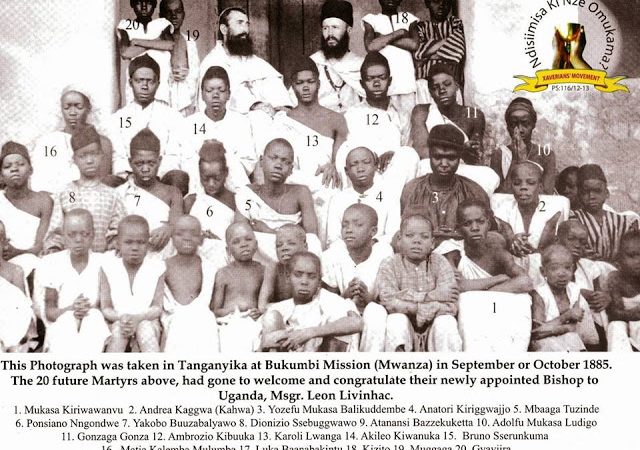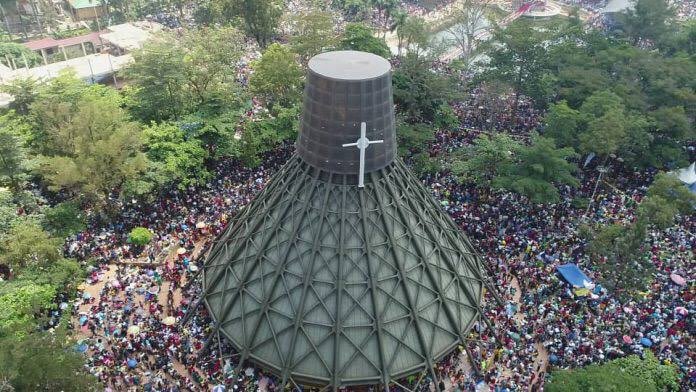Uganda Martyrs
Uganda Martyrs are the special celebrated people that gave their lives for Christianity in the colonial times and have now become a pillar in Christianity. Uganda Martyrs shrine is one of the unique and biggest Roman Catholic Church in Africa which was constructed in commemoration of the 22 catholic martyrs that were killed between 1885 and 1887 by the King of Buganda Kabaka Mwanga 11. Uganda martyr’s shrine is located in Kira Municipality, Wakiso district 15km by road north-eastern part of Kampala city. Construction of Uganda martyrs shrine started in 1967 and was completed in 1975 and it was built on the exact spot where Charles Lwanga and the majority of other martyrs were killed, it’s also the same spot where the original church parish church was standing.

The shrine stands tall and was constructed in an architectural African hut design with wooden doors. The Basilica shrine has 22 copper pillars which are over 100feet long with beautiful and unique interior and exterior designs. The shrine has a seating capacity of about 1000 people whose seats are organized in a circular form. A lake at the shrine was excavated in honour of the catholic martyr’s and contains a pavilion that is built-in the form of a modern boat with clear views of the Namugongo shrine. Pilgrims draw water from the lake and this water is believed to heal different diseases. The pavilion is grass thatched was constructed in circular form just like the shrine and is an area where the main celebrants sit during big and special occasions like martyrs day with a seating capacity of about 300 priests and bishops. When the shrine was completed part of the relics were returned to the shrine for veneration and were hanged in a glass in front of the shrine Altar.
History of Uganda Martyrs Shrine Namogongo
The Catholic martyrs were 24 and 22 were killed under the orders of Kabaka Mwanga of Buganda in 1885 and 1887 due to refusal of denouncing Christian faith which had been introduced by Kabaka Mwanga’s father. Among the 22 Uganda Martyrs, some were pages in the king’s palace while others were working as chefs in the homesteads when they started believing in Christian religion before there were martyred. 13 of the 22 martyrs were burnt at Namugongo while 9 were killed in different places. Joseph Mukasa Balikuddembe a Christian leader and a majordomo or chief steward to the king was the first one to be killed in November 1885. Joseph Mukisa was beheaded and burnt at Nakivubo swamp in Kampala because he had pleaded with king Mwanga not to kill Bishop James Hannington who was at that an Anglican missionary that entered Buganda through the backdoor also known as Busoga.
The 12 catholic martyrs that were burnt in Namugongo holocaust include Achilles Kiwanuka, Ambrose Kibuuka, Luke Banabakintu, Adolphus Mukasa Ludigo, Anatoli Kiriggwajjo, Bruno Sserunkuuma, Gyavira, Kizito, James Buzaalilyawo, Mbanga Tuzinde, Mukasa Kiriwawanvu, and Muggaga. These catholic martyrs were burnt together with 13 Anglican Martyrs and six prisoners that were on death sentence for other offenses committed.
The Catholic martyrs that were killed outside Namugongo include Atthanasius Bazzekuketta and Mukasa Balikuddembe who were killed at Balikuddembe market, Pontian Ngondwe that was killed at Kyamula, Ssebuggwaawo Denis and Andrew Kaggwa that were killed at Munyonyo, Matthias Kalemba Mulumba that was killed at old Kampala, Gonzaga Gonza killed at Kamuli Lubaawo, Neo Mawaggali killed at Kiyinda Mityana and John Mary Muzeeyi who was the last one out of the 22 martyrs to be killed was beheaded on 27th January 1887 and his body was thrown into a swamp at Kisenyi-Mengo.
On 3rd June 1886, Charles Lwanga who was among the 22 catholic martyr’s had become the Christian leader of the catholic and protestant religion after the death of Joseph Mukasa became a victim of the holocaust where Senkoole picked Charles Lwanga to be the next victim. Senkoole took Lwanga to a spot about 50yards from the road and allowed him to arrange his own death bed of firewood, he was wrapped in reeds and was burnt slowly from the feet to the head where he made no cry but rather twisted and moaned to his death.
After the Uganda martyrs had been killed, the executers remained at the scene adding more firewood to the fire so as to ensure that all the remains of the victims burned to ashes because the king considered the victims unworthy for descent burials and the person who would bury any victims remain would be considered a traitor, therefore, their body remains remained unburied. Six months after the 22 catholic martyrs were killed, three Christians namely Matayo Kirevu, Bwaliri Kamywa and Lewo Lwanga who had fear of being charged with treason went to Namugongo one night and collected the remains of st Charles Lwanga. By the next morning at around 8 am they had delivered the remains to Fr Lourdel at the mission where the bones were cleaned and wrapped in a red cloth, put in a copper case and buried in the sacristy at Nabulagala church. Later on, the mission was deserted and the church was burnt down due to religious wars and the box with the remains was lost.
In November 1892 a catechist who was digging his garden recovered the box with the remains of St Charles Lwanga and was returned by Henry who was the Archbishop of Buganda. The remains were stored at the Archbishop’s chapel and later taken to Saint Peters Basilica, Rome for canonization ceremony together with other martyrs in 1964 by Pope Paul VI.
The 2 Catholic martyrs out of the 24 were killed in Paimol Gulu in northern Uganda in 1918. They were catechist namely Daudi Okello and Jildo Irwa who belonged to the Acholi tribe and received baptism and confirmation on the same day. They used to spread the gospel of faith by word and deeds and had moved outside their ethnic group and started spreading the gospel, united the church, promoted peace among the people among others. Daudi and Jildo were murdered by a party of raiders where they were dragged from the hut, pushed to the grounds and pierced their bodies with spears. The two bodies of Daudi and Jildo were not buried until a few days later when some local people tied the bodies with ropes and dragged them to an empty termite hill. The remains of Daudi Okello and Jildo Irwa were collected and taken to the mission church of Kitgum at the sacred heart altar foot in February 1926.

Uganda celebrates Martyrs Day on 3rd June every year and it has been the same for the past 96 years. it was declared a public holiday where thousands of pilgrims from within and outside Uganda, for example, Kenya, Tanzania, and other countries, students from religious schools, clergy walk from all directions barefooted to Namugongo shrine as a sacrifice in honor of the martyrs who were killed because of their strong Christian Faith. Uganda Martyr’s day is filled with several events such as prayers, baptism, plays, songs, food among others because it’s a special day in Uganda.
Uganda Martyrs Shrine Namugongo is an interesting religious tour destination in Uganda that should be visited by religious and other visitors during their tour in Kampala city.


